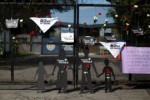Sachsenhausen concentration camp: Nazi terror near Berlin
When the liberators reached the Sachsenhausen concentration camp, they encountered around 3,000 prisoners, nurses, and doctors. For around 300 of the prisoners, however, the Polish and Soviet soldiers had come too late. They died shortly afterwards as a result of the brutal treatment by the Nazis.
The evacuation of the concentration camp located north of Berlin had already begun the day before: More than 30,000 prisoners were sent on death marches by the fleeing Nazis, and several thousand did not survive the agony.
In total, at least 200,000 people from around 40 countries were imprisoned in Sachsenhausen and numerous satellite camps between 1936 and 1945.
By the end of World War II, tens of thousands had died — from hunger, disease, abuse, medical experiments, and forced labor. In the fall of 1941 alone, at least 10,000 Soviet prisoners of war, including many Jews, were murdered in a specially designed execution gallery or gassed in modified trucks.
In the immediate vicinity of the Reich capital Berlin, Sachsenhausen played a special role for the Nazis as a model and training camp. The central administration for the entire concentration camp system was located there as of 1938. One of the most notorious Nazis in Sachsenhausen was Rudolf Höss, who later became the commandant of the Auschwitz extermination camp. He was executed as a war criminal in 1947.
To mark the commemoration of the 80th anniversary of the liberation, six survivors will return to Sachsenhausen at the end of April and beginning of May — three women and three men. As children and young people, they were deported to the main concentration camp or one of its satellite camps in the final years of the war.
Five survivors were from Poland. Ukrainian Mykola........






















 Toi Staff
Toi Staff Belen Fernandez
Belen Fernandez Gideon Levy
Gideon Levy Somdeep Sen
Somdeep Sen Donald Earl Collins
Donald Earl Collins Tarik Cyril Amar
Tarik Cyril Amar Moncef Khane
Moncef Khane Samer Jaber
Samer Jaber Eric Reinhart
Eric Reinhart Marcel Fürstenau
Marcel Fürstenau Yara Hawari
Yara Hawari Rachel Marsden
Rachel Marsden